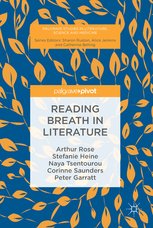Reading Breath in Literature (Rose et al, 2019)
At a key moment in Hamlet’s duel with Laertes, Gertrude cries out that Hamlet ‘is fat and scant of breath’ (5.2.287). Was Hamlet fat, we may ask, as we recall the more memorable Hamlets, cinematic and dramatic? It depends, some editors suggest, on the historical meaning of the word ‘fat’. Perhaps more interestingly, we can track a change in the significance granted Hamlet’s body size, as Elena Levy-Navarro has done. Before the 19th century, it seems, the line occasioned little comment; it was only in the 19th century that a palpable fatphobia began to be evident, linking Hamlet’s body size to his moral uncertainty.

How, then, to step towards a more pertinent question for our readers, might we understand his scantiness of breath? In the immediate context of a duel, it perhaps seems an obvious consequence of exertion, whatever our understanding of ‘fat’. But if you have been a regular reader of this blog, as you will surmise, breathing and breathlessness engage historical context in more complex and more interesting ways, as certain significances advance and recede. Emerging from the literary work of contributors to Life of Breath, the recently published Reading Breath in Literature seeks to place breath in a literary context. In a series of essays that all, at key moments, turn towards the meaning of breath in Hamlet, it addresses the meanings breath acquires when subjected to the scrutiny of literary writers. Considering the workings of breath in literatures from the Medieval Period to the present, in European, American and Postcolonial contexts, across genres from the Romance to the Novel, this collection undertakes a transhistorical survey of breath’s significance in Anglophone literature.
Beginning with the Medieval Period, Corinne Saunders considers the critical role breath plays in reflecting affective experience in Chaucer’s romances. In his treatment of affect, Chaucer draws on medical theories of the time to portray how the movements of the vital spirit create powerful physical responses, which at their most extreme cause swooning and breathlessness. This physiological emphasis, central to Chaucer’s depiction of love and grief, and his treatment of gender, infuses his use of romance conventions with originality.
Moving forward in time to the Early Modern Period, Naya Tsentourou addresses a historical episteme in which the sigh comes to signify wasted energy, with particular implications for the staging and direction of Hamlet. The essay traces the slippery significations of sighing: hypocritical, instrumental, communicative, self-consuming, and self-revealing, breathing in Hamlet has no fixed referent but shifts as often as the characters shift their position and perspective, constantly pointing to the impossibility of ordering an individual’s or even a state’s disordered breathing pattern.
Peter Garratt’s contribution is dedicated to the impact respiration – as metaphor, physiological process, and embodied response – had on Victorian aesthetics. Late nineteenth-century attempts to define aesthetic experience in terms of its attendant physiological reactions still drew on breath’s immaterial poetic associations (air, wind, spirit) while being alert to the way respiratory control shifts easily between voluntary and involuntary modes of experience (will/automation).
Stefanie Heine explores how in post-war America the Beat writers configured a body-based poetics around breath that parallels concerns with orality and breathing in Ancient Rhetoric. Tracing these parallels shows how the supposedly new American poetry is in fact a renaissance of classical thought and the idea of a pure bodily writing evoked by Allen Ginsberg and Jack Kerouac is upset by the cultural memory invoked.
Finally, Arthur Rose addresses how breath becomes a socio-political concern in Postcolonial literature, focusing particularly on Salman Rushdie. Considering the relation between breathing bodies and contested environments in The Moor’s Last Sigh, the essay investigates how a combat breathing in Franz Fanon’s sense links the postcolonial subject to their condition of being-in-the-world.
In its earliest iterations, this book’s working title was Breathroutes: Interventions into Respiratory Writing. With this implicit reference to Paul Celan, we wanted to provoke our readers into thinking of “breath” as more than simply a physiological signifier that maps onto an aesthetic preoccupation. We hope our essays track those moments when texts turn towards their own relationship with breath, to think through breath. In this way, we follow Jean-Thomas Tremblay, who concludes his introduction to a recent special issue with the poignant phrase: “no one is ever just breathing.” At the same time, we offer these essays as avenues for opening up, rather than closing down, further efforts to read breath in literature.
Reading Breath in Literature in now available to download for free here.
Picture credit: Hamlet: Act IV, Scene V (Ophelia Before the King and Queen) by Benjamin West (1792)



